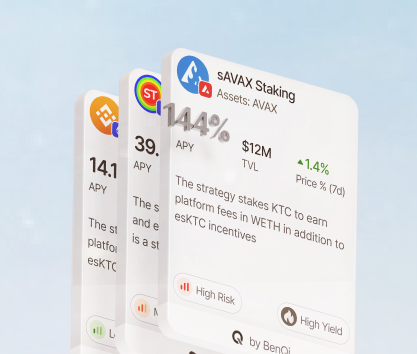The DeFi ecosystem is an excellent environment for efficient money-making thanks to the proliferation of novel investment instruments that have never existed before. Yield farming is still a large market despite the contraction after 2022. With several thousand different pools offering generous rewards to their investors, finding a good option is both easy and difficult.
We will talk about different types of protocols offering rewards in native, governance, or layer 2 tokens in exchange for capital locked in their liquidity or lending pools. Note that some yield aggregators and other similar protocols also offer unique rewards in some cases. For instance, Yearn Finance has several pools offering different types of tokens as rewards. The DAI pool has a 3.56% base APY and up to 9.82% in rewards with the 30-day mean average reaching 18.66% in October 2024.
Cryptocurrency farming protocols
With over 500 protocols offering thousands of pools across 94 blockchains, it is quite challenging to find an efficient method of capital allocation even if you have some experience in financial markets. Newcomers to the DeFi sector are often puzzled by high yields and incredibly generous payouts. Such high numbers often scare away investors who are used to hearing loud promises exclusively from scammers. However, there is a solid explanation for the generosity of the DeFi ecosystem.
DeFi yield mechanisms
The Decentralized Finance ecosystem is incredibly complicated due to the sheer number of available investment opportunities and different reward structures. The simplest way to explain how these protocols can easily provide higher rates compared to tradfi institutions is to give you an example that can illustrate the mechanism as well as possible.
All protocols can issue tokens that have some sort of utility. They can be designed to reduce fees or pay for protocol-specific services. Governance tokens are utilized to encourage the community to actively participate in the development process and vote on important decisions that affect the very functionality of the protocol.
Let’s take decentralized exchange (DEX) farming:
- All DEXes desperately need liquidity to work as intended. Since most Dapps are non-custodial, it means that they must find a way to tap into liquidity sourced from willingly participating contributors.
- Due to the intense competition in the sector with over 1,400 DEXes across 90 chains, attracting liquidity providers is a challenging task. Protocols have to offer generous APYs to entice investors to put money into their pools.
- Base APYs can be provided only through revenues generated by protocols. Additionally, gas fee considerations also affect potential rates. DEXes cannot pay in base currency more than they earn in commissions.
- To bypass this issue, DEXes issue governance tokens (i.e. Curve DAO) or native tokens which are paid on top of whatever base APY they can muster. These tokens can be incredibly valuable depending on their utility and popularity.
- The issue with this particular setup is that returns diminish over time. Since the issuance of tokens is directly promoted by the participation of liquidity providers or lenders, the increasing popularity of a protocol leads to a growing supply of reward tokens. When enough holders liquidate their positions, the price inevitably drops.
Considering tokenomics and inflation when choosing where to park your capital is crucial. Due to the potential inflationary effect of the rapid growth of supply, investing in protocols paying outrageous rates in rewards is not an effective strategy in the long run.
Liquidity provision rewards
Profitability differs depending on the protocol, its native blockchain, and some other factors. Often, newer projects offer excellent yields to their investors just to secure an audience. Below are some examples of pools with rewards (all numbers are as of October 2024):
- The WETH-BSX pool on the BaseSwap DEX (Base) has an impressive 434% reward APY paid in BSWAP tokens on top of a respectable 24.87% base APY. The chain itself is not hugely popular and the total value locked (TVL) is just $300K but it is still one of the most generous reward APYs out there.
- Aerodrome is one of the newer DEXes operating on the Base chain. The WETH-OX pool with over $2.5 million TVL has a massive 261% AERO APY. The AERO token has been doing quite well throughout the year growing by 12.5 times since launching.
- Ston.fi is a popular TON exchange that has a utility-oriented NOT-TON pool with a TVL of over $6.14 million. The pool offers a 4.88% base APY and 34.4% in TON rewards for a grand total of 39.2% APY. TON is also a great performer with a 980% growth over the last three years.
Automated market makers (AMM)
These protocols use liquidity from across the DeFi ecosystem and allow users to search for the best terms quickly. Among these protocols, some stand out more than others. Below are several interesting projects from this category:
- Cetus AMM on the Sui chain provides the necessary level of user activity within the network. The protocol has a solid $197 million TVL, has 380 pools averaging 72.82% APY in October 2024. The DEEP-SUI pool has a 228% base APY and 126% in rewards.
- Ekubo on Starknet has a $60 million TVL. It is the main AMM protocol on this chain with a respectable $320 million monthly volume. This market maker has 16 pools averaging 24.88%. Investing in the STRK-ETH pool yields 3.61% as base APY and up to 73.4% in STRK rewards.
Yield optimization strategies
Contemporary investors must focus on creating a balanced portfolio capable of reaching high ROI without exposing themselves to excessive risks. While a perfect strategy to achieve the right composition of positions does not exist, you can follow some tips to make better investment choices. Below are some basic suggestions for newcomers interested in DeFi investments:
- Try to mitigate impermanent loss that occurs when the market price of an asset locked in a pool drops below the entry price. Since the price can recover, these are not permanent until you liquidate a position. It is quite hard to predict the market. However, you can use an impermanent loss calculator to estimate how much you might lose.
- Do not chase the biggest number. Often, high-reward APYs are paid by protocols operating on less popular chains like Solana or Base. They often have pools with memecoins or rewards in tokens that quickly lose market value. With wonky token emission schedules and low adoption rates, these protocols do not generate real profits. Despite earning native or governance tokens at impressive rates, you will lose value overall.
- Try focusing on tokens that have a proven track record. While AERO might seem like a good target asset since it gained over 12,500% over the year, it is a token that has been around for less than 12 months. It means that the long-term return on investments may be quite low or easily outpaced by other options. CRV, on the other hand, has a lower price yet enjoys high trading volumes and can be used in decentralized governance at Curve DAO.
- Make sure to work with protocols that use audited smart contracts. These tiny on-chain applications can have vulnerabilities. For instance, DMM Bitcoin, a large Japanese crypto exchange, suffered from an attack on their smart contracts losing over 4,500 BTC. Running bug bounty programs can help just by inviting external experts to audit the code. Open-source protocols also have strong security thanks to public scrutiny.
The best thing you can do as an investor is to focus on DYOR (do your own research) and learn about protocols as much as possible. You can source information from various platforms. Reddit, Discord communities, and Telegram groups can be valuable sources of educational information. You should never think that you know enough.
Advantages of smart contract yield generation
Farming rewards on various protocols can be rewarding even without any additional boons. Many investors think it is both profitable and fun to invest one token and receive the bulk of returns in another. However, the gamification of the investment process is not the only great thing about yield farming. Below are some unique advantages:
- Strictly non-custodial business. Investors remain in full control over their finances during the investment process. It means that you are never in a dangerous position to lose funds to a single-point attack or due to mismanagement of a central entity.
- Strong security. Despite the existence of unique risks for both investors and platforms (i.e. flash loan attacks), the DeFi ecosystem is still incredibly reliable if you, as a user, know what to do and how to safely store digital assets.
- Incredible accessibility. Since DeFi protocols do not abide by KYC/AML guidelines, you can access them if you have an internet connection. The ability to invest from anywhere in the world is a way to democratize finance for everyone.
- Novel investment tools. The DeFi sector has many interesting instruments for creative investors. For example, you can farm yields with stablecoins despite not having them. By staking ETH with Lido, you receive STETH. You can use these tokens as collateral to take out a loan in USDC, DAI, or USDT. Invest them in a high-yield protocol for additional rewards and enjoy higher profit.
These benefits can be incredibly useful to an investor who does not want to sit on their money. Proactive enthusiasts extract every single percentile point from various protocols to achieve incredible profitability.
Cross-chain yield opportunities
The DeFi sector has a notable weakness — low interoperability between different blockchains. All trades between different networks are handled by bridges which are often held back by Oracles (centralized entities used to settle trades outside of the DeFi ecosystem). It can be dangerous to use them, but investors may be enticed to allocate capital to liquidity pools like one offered by Across, a bridge operating on the Ethereum network.For example, the protocol has a USDC pool with a relatively low base APY of just 0.9% but a very high reward APY of 6% paid in ACX tokens.
The main takeaway
Yield farming can be a highly profitable endeavor for proactive investors willing to learn something new to make sound decisions. However, it is also a very dangerous environment where newcomers feel overwhelmed by the sheer number of available options and struggle to navigate the ecosystem successfully. We strongly believe that there is a place for DeFi investments in any portfolio.









